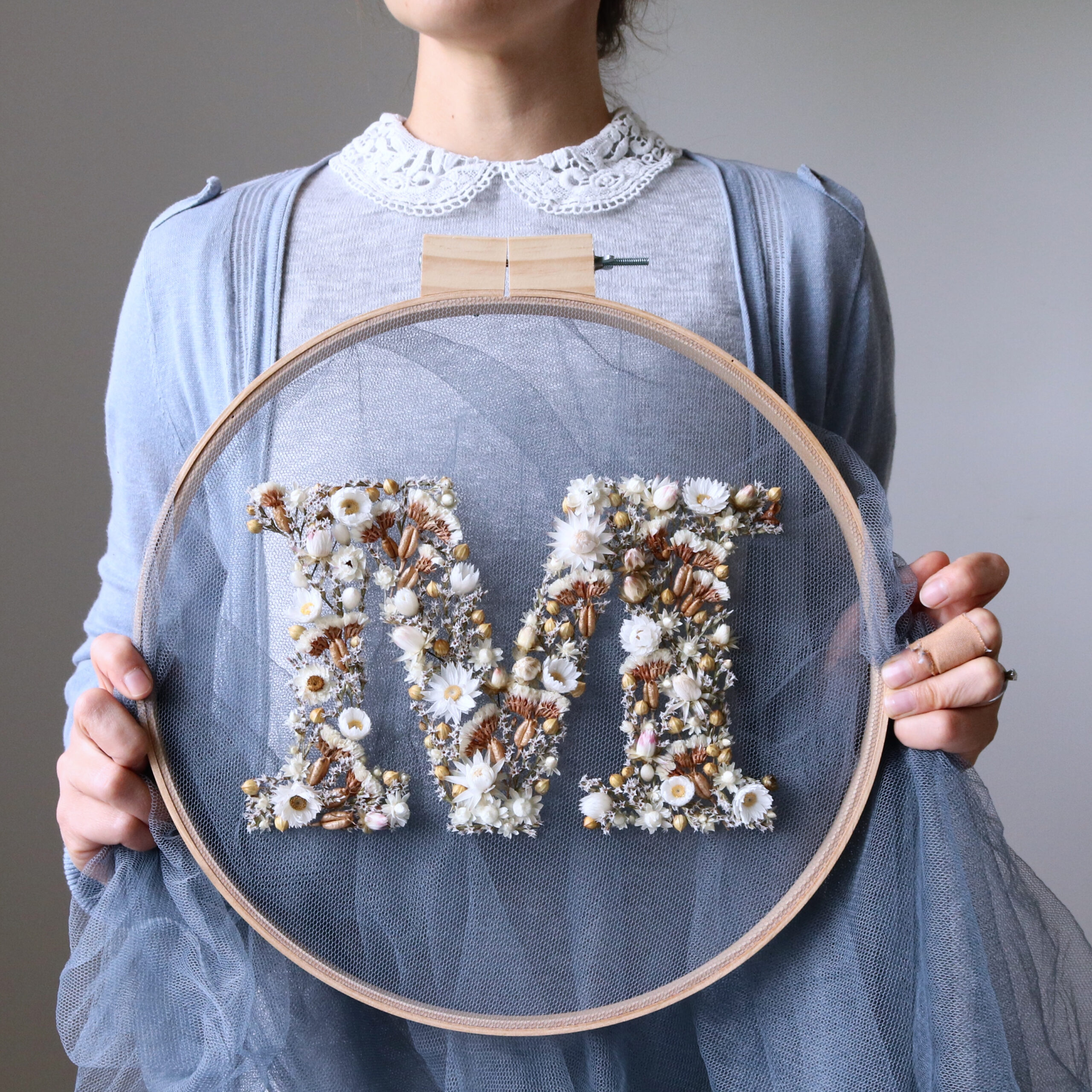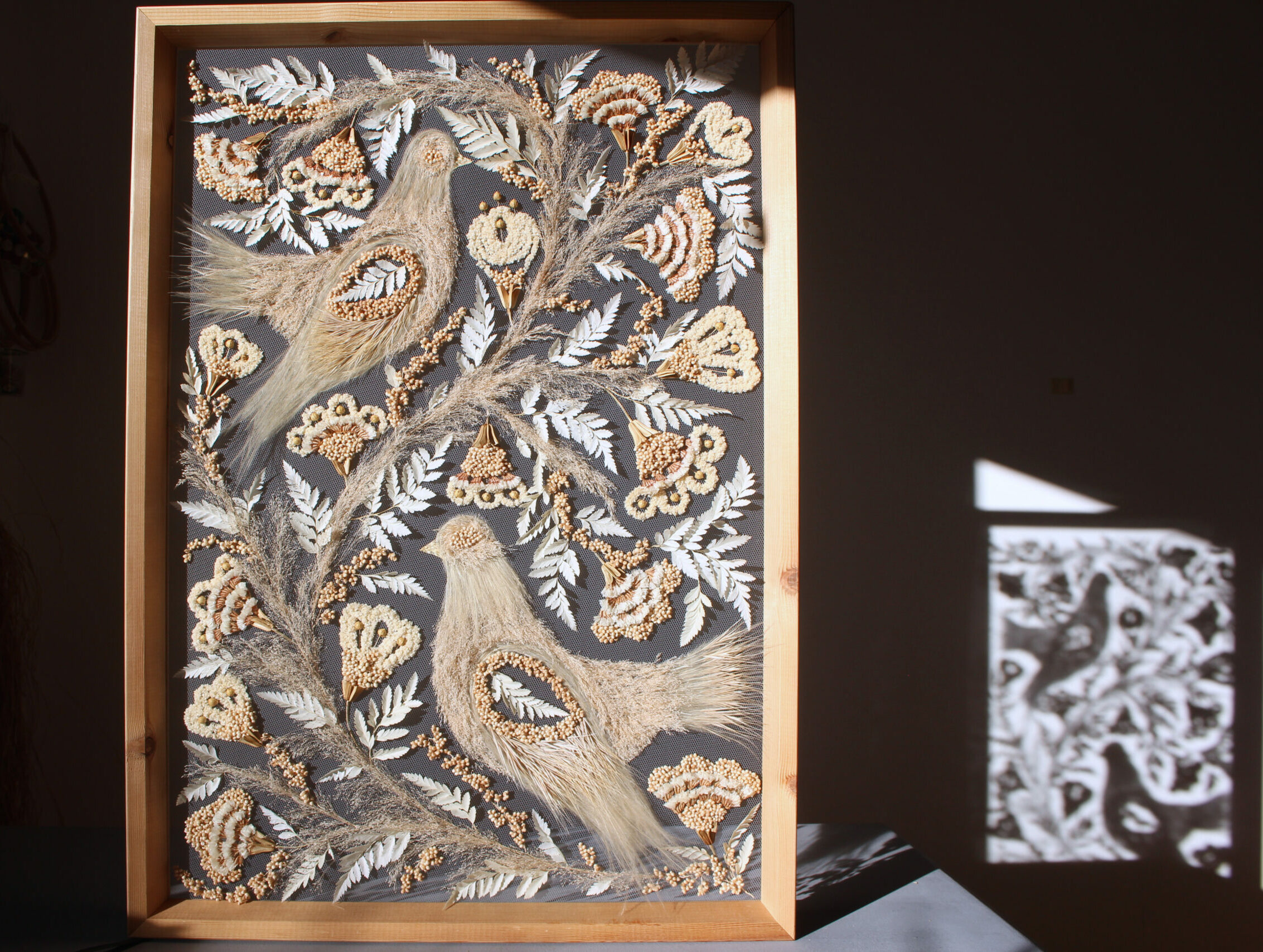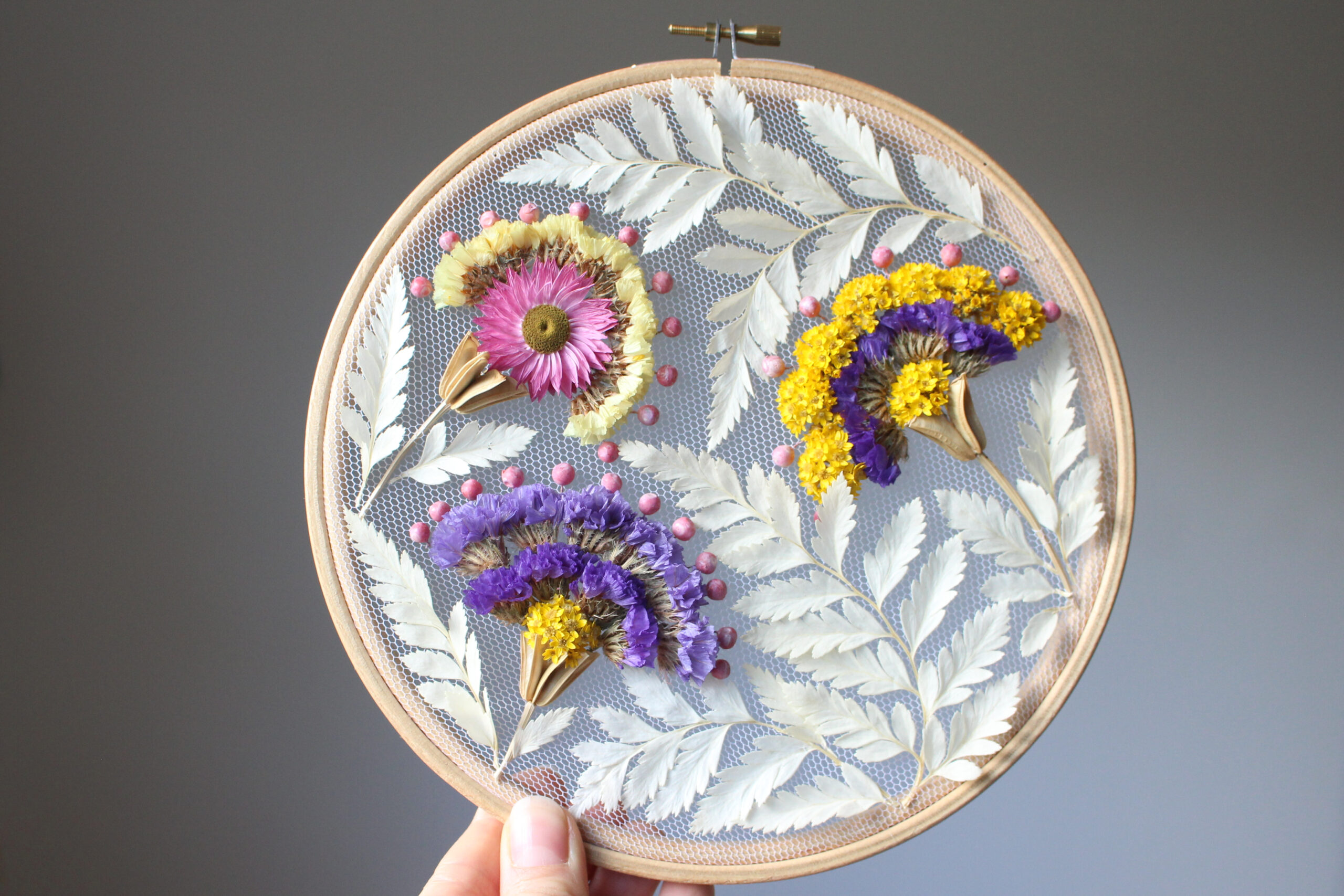Olga Prinku is this year’s resident artist for the James Cropper Wainwright Prize, in a year in which we celebrate our tenth anniversary. Olga is an originator of the craft of flowers-on-tulle embroidery – a creative practice that involves using nature-as-thread. Her creations are staggeringly beautiful and intricate, garnering her huge popularity and attention in the art and textile world.
We had the pleasure to sit down with Olga to speak to her about her journey, and how nature has become integral to her creative practice.
Tell us a bit about your journey as an artist, from a graphic designer to your discovery of embroidery-on-tulle.
I’d studied graphic design at the Cumbria Institute of the Arts, now the University of Cumbria, and I was working as a graphic designer when I took a career break to start a family. The discovery of flowers-on-tulle embroidery came out of my hobby of wreath-making – one day I experimented with using a garden sieve as a frame for a wreath, poking the stems of the branches through the mesh, and I realised a similar idea could work with dried flowers and tulle fabric.
As I developed the craft of embroidering with real, organic materials, I found myself drawing a lot on the general principles of art and design that I’d learned in my graphic design degree. Not least in the series of typographical works that I’m exhibiting at the Brewery Arts Centre in Kendal during the week of the Wainwright Prize presentation.

Your work is strongly inspired by nature. What do you feel your works reveal or convey about the natural world?
I think we can often overlook a lot of the beauty in nature when we don’t take the time to look closely at the patterns of the natural world and the changing of the seasons. That was certainly true for me, even when I used to love walking in the Lake District before I came up with the idea of creating art by embroidering with natural materials.
Once I’d embarked on the flowers-on-tulle journey, I found myself seeing things on these walks that I’d never noticed before – the structures of leaves, for example, or seedheads, or even plants we might think of as weeds. In my works, I’m trying to draw attention to the richness of the beauty in the natural world by selecting various organic materials and recombining them in new ways.
You also mention folklore as an inspiration, tell us a bit more about this. Are there any folk stories that you love?
I was born and grew up in the Republic of Moldova, which was part of the Soviet Union, but has historically been part of Romania and shares its rich heritage. Like many of the surrounding countries, it has some distinctive patterns that you’ll see embroidered into traditional dress, tapestries and woven rugs. By recreating some of these patterns with dried flowers, I like to make the link between the natural world and cultural ideas that reach back into the past.
I’m also fascinated by the history of using embroidery to depict scenes and tell stories through tapestries, so as well as the more abstract shapes, I enjoy creating larger-scale works that depict, for example, scenes of trees and birds. The choice of organic material can add an extra dimension to the message of a piece, as compared to using only thread.

Why do you think it’s important to explore our natural world through creativity?
We’re all increasingly aware nowadays of the speed at which the natural world is changing, and the need to adapt our human activities to take more care of the future of the environment and biodiversity. I think that engaging creatively with natural materials is a great way to deepen our appreciation of connections in nature, and remind ourselves how we relate to and depend on the natural world.
Something I think about constantly while creating is the way nature combines the very different qualities of fragility and strength. Each phase of a plant’s lifecycle passes so quickly and individual flowers and flowers are so easily broken, but everywhere you see plants trying to grow even in the most unpromising places. We need to find ways to nurture the fragility and work with the strength.
How do you find the process of a craft that is so intricate and detailed? Is it mindful?
Absolutely, and that’s very much linked to the idea of deepening appreciation of how we’re connected to the wider world. Because many of the individual pieces of organic material I work with are so delicate, it’s easy to snap them if I’m not fully paying attention, so creating flowers-on-tulle artworks necessarily involves me getting absorbed in the moment. If I’m distracted, it doesn’t work.
But when the creative process is going well, I can find myself entering into a state of flow where it almost feels like each new flower I pick up is telling me where it wants to go in the fabric. It’s the closest I come to a meditative experience.

Which artists inspire you most?
Too many to mention! When I was exhibiting earlier this year at Collect, an annual event in London organised by the Crafts Council, I loved seeing up close the work of Simone Pheulpin, who uses fabric and pins to create these amazing pieces that look like natural geological formations, rocks, cliffs and the landscape. I’ve recently been experimenting with incorporating gold leaf in my work and admiring the creations of Olga de Amaral, who combines gold leaf with fibres to “weave a rock”.
As I like to say I use “nature as my thread”, I’m always drawn to artists who find unexpected ways to work with either nature or thread. For example, I’ve recently become fascinated by how Chiharu Shiota uses thread to weave extraordinary three-dimensional spaces, and I’ve always loved the botanical plastercasts of my friend and fellow artist Rachel Dein.
How does it feel to have such a large following, to have people connect so strongly with your creations?
It’s always nice to feel that you’re doing something that resonates. I love to experiment with fresh ideas and techniques, and whenever you push your work in a new direction you always feel like you’re taking a bit of a risk so it’s reassuring when I get feedback from people who appreciate what I’m trying to achieve and the effort that goes into it.

And lastly, what future projects are you excited about?
I’m excited that in 2024 I’m going to be the artist in residence at Hidcote, the National Trust property in the Cotswolds. I’ve visited the beautiful gardens there at different times this year to forage for materials, and over the course of the winter, I’m looking forward to creating some new works to exhibit there alongside a few other of my favourite pieces that connect visually with the structure of the garden.
Privacy Policy | Terms & Conditions | Website by Milk & Tweed
| Cookie | Duration | Description |
|---|---|---|
| cookielawinfo-checkbox-analytics | 11 months | This cookie is set by GDPR Cookie Consent plugin. The cookie is used to store the user consent for the cookies in the category "Analytics". |
| cookielawinfo-checkbox-functional | 11 months | The cookie is set by GDPR cookie consent to record the user consent for the cookies in the category "Functional". |
| cookielawinfo-checkbox-necessary | 11 months | This cookie is set by GDPR Cookie Consent plugin. The cookies is used to store the user consent for the cookies in the category "Necessary". |
| cookielawinfo-checkbox-others | 11 months | This cookie is set by GDPR Cookie Consent plugin. The cookie is used to store the user consent for the cookies in the category "Other. |
| cookielawinfo-checkbox-performance | 11 months | This cookie is set by GDPR Cookie Consent plugin. The cookie is used to store the user consent for the cookies in the category "Performance". |
| viewed_cookie_policy | 11 months | The cookie is set by the GDPR Cookie Consent plugin and is used to store whether or not user has consented to the use of cookies. It does not store any personal data. |